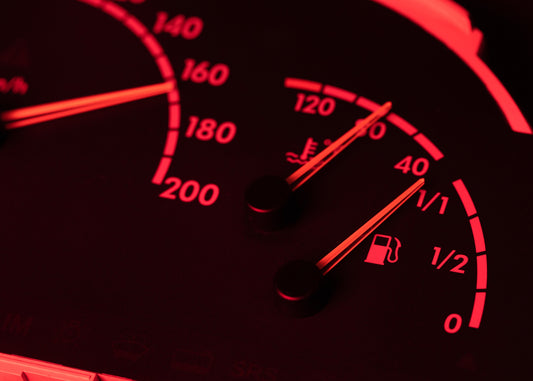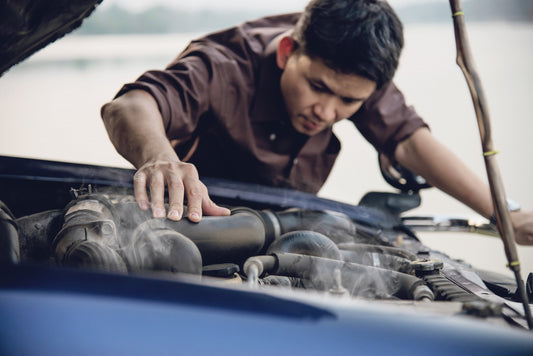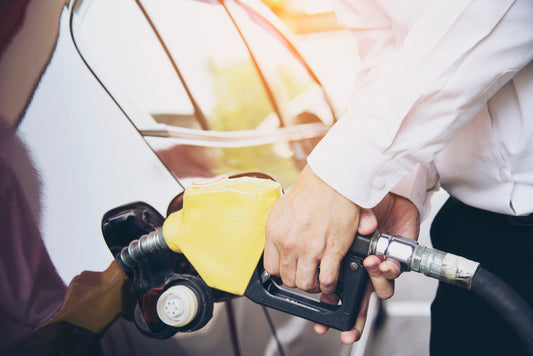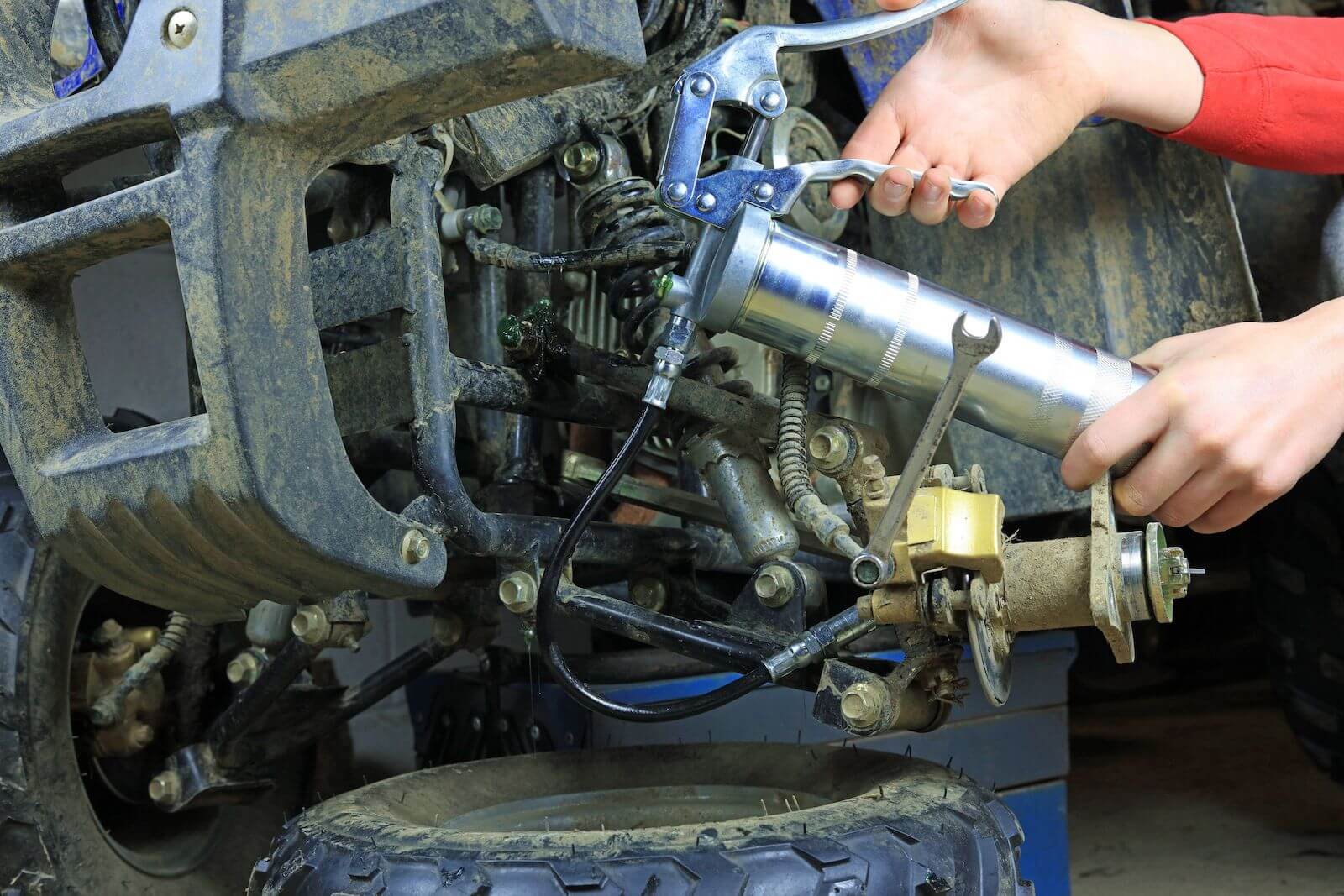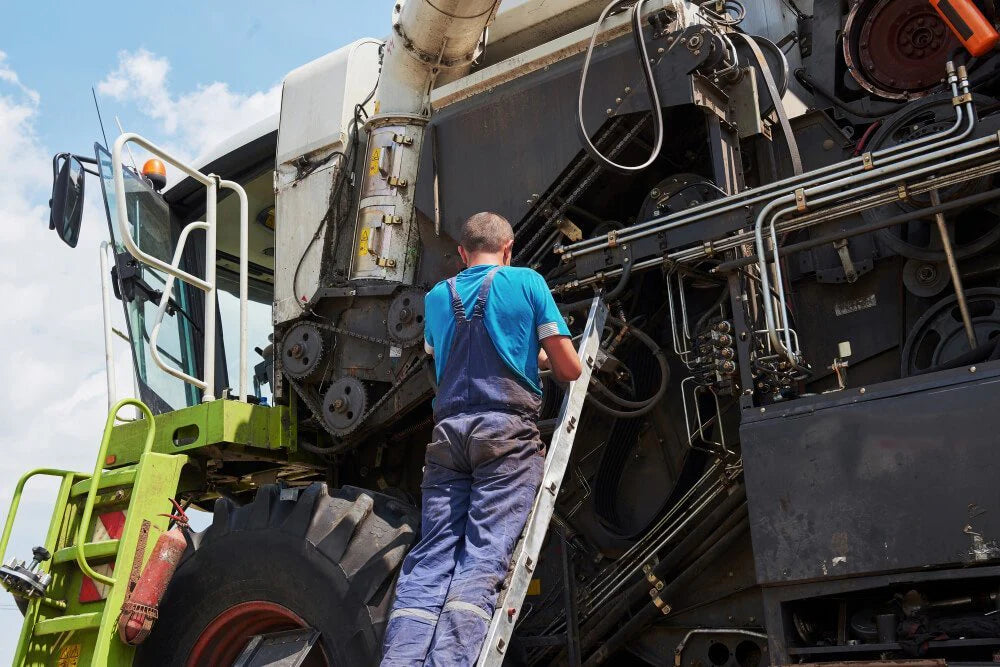Maintaining your vehicle’s ball joints is essential for the proper functioning of its suspension and steering system. Greasing ball joints helps prevent metal-to-metal contact and extends their lifespan. There are two types of ball joints: those with a zerk fitting and those without.
In this guide, we will explore each type of ball joint, how to identify them, and the best practices for greasing them.
Let’s dive in, and by the end, you should feel confident in understanding and maintaining your car’s ball joints.
Identifying the type of ball joint: With or Without Zerk Fitting
Before you can step into the world of machine maintenance, particularly greasing ball joints, it’s vital to understand the two broad categories of ball joints that exist: those with a zerk fitting and those without.
1. Ball joints with zerk fitting
Zerk fittings, also known as grease fittings or nipples, are small metal components usually made of steel, stainless steel, or brass, and have a check valve to enable grease injection without letting it escape.

These fittings allow you to easily grease ball joints and other mechanical parts to minimize friction, extend component life, and ensure smooth operation.
To locate the zerk fitting on your ball joint, follow these simple steps:
Park your vehicle on a level surface and apply the parking brake.
Jack up the vehicle to gain access to the ball joints.
Visually inspect the suspension components to identify the ball joint. It should be located near the wheel hub and might be part of the control arm or tie rod end assembly.
Once you locate the ball joint, search for a small nub-like protrusion or a hexagonal bolt head. That’s the zerk fitting.
Lube-Shuttle®: Lever Handle Grease Gun
Lever Handle Air-Tec Lube-Shuttle® Grease Guns are made of the highest quality steel tubes with corrosion-resistant zinc plating.
shop now2. Ball joints without zerk fitting
Sealed ball joints, or those without zerk fittings, are designed as maintenance-free chassis components. These ball joints are pre-greased during manufacturing, and the lubricant remains inside the assembly due to a sealed boot or a metal housing.
Sealed ball joints typically use a higher quality grease and tighter tolerances to reduce the need for ongoing maintenance.
Manufacturers might choose to produce sealed ball joints for several reasons:
Reduced maintenance requirements, making them more convenient for the owner.
Avoiding contamination from dust and debris, which can result in premature wear.
Improved aesthetics, as they don’t have externally visible grease fittings.
However, this also means that sealed ball joints can’t be easily lubricated once the factory grease wears out or becomes contaminated. As a result, replacing the entire ball joint is usually the only option once it has reached the end of its service life.
What to Consider When Buying Best Grease for Ball Joints?
Selecting the right grease for ball joint is crucial in ensuring the proper protection of your ball joints.

Here are some key factors to consider when purchasing grease for your ball joints:
Operating Temperature Range – Choose a grease that can withstand the temperature variations in your specific driving conditions, such as high temperatures during heavy loads or low temperatures during winter months.
Water Resistance – Opt for a grease with excellent water resistance properties to prevent washout and corrosion, especially if you frequently drive in wet or snowy conditions.
Load-bearing Capacity – Your ball joints need a high load-bearing grease to handle the pressures exerted on them during normal driving or extreme situations, such as off-roading. Look for greases with an NLGI (National Lubricating Grease Institute) rating of 2 or higher.
Compatibility – Ensure that the chosen grease is compatible with the materials used in your ball joints, like rubber boots and metal alloy components. Some greases can deteriorate specific types of rubber, causing premature failure.
By carefully using wheel bearings and selecting a suitable grease for your ball joints, you can extend their service life and ensure a smooth and safe driving experience.
Grease Gun Coupler: Lube Shuttle® safeLOCK L Long Reach Grease Coupler
When it comes to couplers, the best grease gun coupler is going to be long enough for the job and durable. You also need a locking grease coupler that will stay locked while you do a task with your hands-free grease gun! Lube Shuttle® has created the best of both worlds in their new safeLOCK Long Reach locking grease coupler.
shop nowGreasing Ball Joints: Step-by-step Instructions
Here’s a step-by-step process you can follow for greasing the ball joints:
1. Preparing the Vehicle
Before you start working with ball joints, the first task is to prep your vehicle. Proper preparation ensures safety and efficiency while working.

Safety precautions (parking brake, wheel chocks, etc.) — The first step is to park your vehicle on a flat, even surface. Apply the parking brake to prevent the car from moving while you’re working on it. Further ensure the stability by placing wheel chocks on both sides of the vehicle’s wheels that remain in contact with the ground. Dress appropriately for the work; wear gloves, safety glasses, and sturdy footwear to protect yourself.
Lifting the vehicle safely (jack stands, lift points, etc.) — Next, you need to lift the vehicle. The car manual can tell you the preferred lift points. Position the jack stands under these points and start raising your vehicle steadily.
Once lifted, make sure your vehicle is steady and secure on the stands before you start working, securing it with jack stands to avoid any potential mishaps.
2. Preparing the Grease Gun
The right tools will make the job easy. The primary tool for high quality grease is typically a grease gun, and preparing it properly is crucial.
Loading the grease gun with the appropriate grease — To load the grease gun, unscrew the top, pull the plunger back, and insert a tube of the appropriate grease. Release the plunger and screw the top back on. Make sure you pump the handle a few times to make the grease is ready to apply.
Attaching required adapters (needle adapter, etc.) — There may be different types of adapters required depending on the ball joint’s design. If your ball joint has a zerk fitting, you’ll need a standard coupler. If it doesn’t, you may need a needle adapter. Attach the adapter securely to the grease gun.
3. Greasing Ball Joints with Zerk Fittings
After the vehicle and tools are ready, it’s time to start the greasing process.
Locating and cleaning the zerk fitting — The zerk fitting is usually located on the lower control arm. Clean it thoroughly to prevent any dirt or grit from getting into the joint.
Connecting the grease gun to the fitting — Apply the end of the grease gun to the zerk fitting. Apply a little bit of pressure until you feel it snap into place.
Applying grease until the boot expands slightly — Pump the handle of the grease gun slowly. This applies the grease to the joint. Start squeezing the handle until you see the rubber boot surrounding the joint expand slightly. This is a sign that the joint is adequately greased.
Disconnecting the grease gun and cleaning any excess grease — Disconnect the grease gun from the zerk fitting and clean any excess grease. Use a clean rag to wipe off any residual grease.
Lube-Shuttle®: Pistol Grip Grease Gun
No mess, no waste, no headaches. Lubricate tools and machinery with this grease gun. Air-Tec Lube-Shuttle® Pistol Grip Grease Guns are made of the highest quality steel tubes with corrosion-resistant zinc plating designed for Lube-Shuttle® System-Cartridges and feature an ergonomically designed pistol grip.
shop now4. Greasing Ball Joints without Zerk Fittings
The process is different for ball joints that don’t use zerk fittings.
Removing the ball joint from the vehicle (specific steps may vary depending on the vehicle model) — You’ll need to use a wrench or other suitable tool to remove the ball joint. Be sure to keep track of all the components and fasteners, so you can reassemble it correctly.
Carefully opening the ball joint dust boot without damaging it — Once you’ve removed the joint, you can access the dust boot. This needs to be removed carefully, as damaging it will allow dirt and other contaminants inside the joint. Use a small flathead screwdriver to gently pry open the boot.
Applying grease to the ball joint using a grease gun or another suitable method — With the dust boot removed, you can apply grease directly to the joint. Be generous with the grease application but make sure not to overdo it, as excess grease will attract dirt.
Reattaching the dust boot and reassembling the ball joint in the vehicle — Finally, put the dust boot back on and reassemble the ball joint in the vehicle. Be meticulous during reassembly to ensure everything aligns and fits correctly.
Can I use General-purpose Grease for Ball Joints?
Choosing the right grease for ball joints is a crucial aspect of maintaining their high performance, and longevity. Although it might be tempting to grab any general-purpose grease, it’s worth bearing in mind the specific requirements of ball joint lubrication. Ball joints undergo immense pressure and high temperatures due to their position and function in the car’s suspension.

Consequently, the grease needs to be highly resistant to extreme pressure, and temperature to ensure proper lubrication under various operating conditions. High-quality lithium or molybdenum-disulfide (moly) greases tend to be ideal for ball joint lubrication.
Moreover, some synthetic greases offer excellent performance across a wide temperature range and demonstrate enhanced resistance to water washout and oxidation. Therefore, they offer longer-lasting protection and less frequent maintenance.
Application of Grease to Ball Joints
The application of grease to your vehicle’s ball joints is a fundamental element of maintenance. Greasing your ball joints regularly ensures smooth operation throughout the life of your car.
The process will differ depending on whether your ball joints have a Zerk fitting or not.
With a Zerk Fitting
Firstly, if your ball joint has a Zerk fitting, begin by attaching the grease gun to it. Apply pressure to the gun until you see the rubber boot of the ball joint expanding slightly – a sign that sufficient grease has been applied.
Cleanup is crucial after the application process to prevent the dirt and residue from contradicting the effect of the grease. Use a clean rag to wipe off any leftover grease around the ball joint.
Without a Zerk Fitting
If your ball joint does not have a Zerk fitting, the greasing process is more involved. You’ll need to remove the ball joint and detach the dust boot to expose the joint itself. Apply grease directly to the joint and ensure a meticulous reassembly afterward.
Remember to handle the dust boot with care and refrain from applying too much grease, as exceeding the limit may collect dirt.
AirTec Grease: G200 Multi-Purpose Plus
AirTec’s G200 Grease is a premium multi-purpose grease. It features a calcium sulfonate complex thickener, EP additives, and a heavier base oil than most multi-purpose greases.
shop nowWhy Proper Lubrication Matters for Ball Joints?
Ball joints act as pivot points between the tires and the suspension of the vehicle. They enable the wheels to move up and down and (with the help of tie rod ends) turn left and right.
They bear a significant amount of load and constant movement, laying groundwork for wear-and-tear. Proper lubrication is vital for the well-being of these parts.

Lubrication reduces friction, heat, noise during operation, and prevents metal-on-metal contact, thus avoiding premature wear and tear. It also helps in flushing out dirt and contaminants that might have settled in the joint.
A poorly lubricated ball joint can result in unexpected breakdowns, poor handling, or even cause a dangerous driving situation. Regular and proper lubrication ensures that your vehicle’s performance remains smooth and safe.
How Often Should I Apply Grease to my Ball Joints?
The frequency of greasing your ball joints can greatly vary, depending on factors such as driving conditions, vehicle type, and the quality of the parts used. As a general rule, it’s advisable to lubricate your ball joints every time you change your vehicle’s oil.
Typically, an oil change occurs every 3,000-5,000 miles, so this would be a safe and adequate estimate for when to apply grease. If your vehicle drives under harsh conditions — such as on dirt roads or uneven terrains — more frequent lubrication may be needed.
How Can I Tell if I Need to Grease my Ball Joints?
Several indicators can help determine if your ball joints need greasing. It’s often a sensible idea to start with a visual check-up. Inspecting the rubber boot for any damage or grease-leaking will provide initial hints about the need for maintenance.
In terms of physical symptoms, strange noises are often a giveaway. If you begin to hear a creaking or squeaking sound when steering, that’s a strong sign that the joints need lubrication.

Another clue can be excessive vibration or an unusually shaky steering wheel at high speeds, indicating potential wear in the joint.
Remember, proactive maintenance can mean the difference between minor touch-ups and costly repairs. So, if you notice any of these signs or it’s been a while since your last servicing, maybe it’s time to break out the grease gun. Regularly check and address anomalies to ensure the longevity and optimal performance of your vehicle.
Long Reach Needle Grease tip
This is preferred for any machines that have grease fittings that are hard to reach. Hard to reach zerk fittings may be inside a joint, behind some hoses or wires, or behind a guard or shield.
shop nowOur Verdict on the Best Ball Joint Grease
Selecting the best ball joint grease often depends on the vehicle, the surrounding environment, and the driving conditions. High-pressure-rated greases, like molybdenum disulfide, are typically the best due to their incredible resiliency under immense pressures and temperatures.
Synthetic greases are another excellent choice due to their broad and wide operating temperature range of ranges and superior resistance to water washouts and oxidation. This results in longer-lasting protection and reduced maintenance frequency.
Although it might be tempting to use a general-purpose grease, it’s essential to pay heed to the specific requirements of your ball joint lubrication. Always check your vehicle manufacturer’s recommendation to pick the best grease.
FAQs
Can I use any type of grease for my ball joints?
While technically any grease can be used for ball joints, it’s best to use high-quality lithium or molybdenum-disulfide (moly) greases. General-purpose greases often don’t withstand the high-pressure and high-temperature conditions that ball joints experience.
What if I don’t grease my ball joints?
Neglecting to grease your ball joints can lead to a lack of lubrication, causing unnecessary friction and wear. Over time, this can engender untimely wear and tear, lead to a reduction in ball joint performance, and ultimately, increase your safety risk while driving.
Does driving in harsh conditions affect how often I need to grease my ball joints?
Yes, driving in abrasive road conditions or climates can hasten the need for greasing your ball joints. Dust, grit, and water can expedite wear and tear on the ball joints, necessitating frequent greasing to maintain optimal performance.
Can the grease in my ball joints be changed, or do I have to replace the whole joint?
The grease in ball joints can indeed be replaced without swapping out the complete joint. However, if the ball joint shows signs of excessive wear or damage, it might be prudent to replace the whole joint.
Can you use wheel bearing grease on ball joints?
While wheel bearing grease could be used on ball joints in an emergency, it’s not ideal. Ball joint grease generally needs to withstand greater pressure and temperature levels than wheel bearing grease. Hence it’s best to use grease specifically designed for ball joints.







